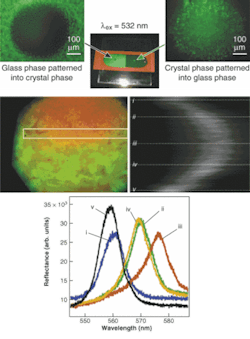Frequency-doubled YAG creates hydrogen nanoparticle structures
By applying frequency-doubled Nd:YAG laser light to self-assembled colloidal crystals created from hydrogel nanoparticles, Georgia Institute of Technology (Atlanta, GA) researchers are creating patterns that may provide a fabrication technique for photonic structures such as optical waveguides and microlenses. The 532-nm laser energy is used to controlled amounts of heat poly-N-isopropylacrylamide nanoparticles, which average 224 nm in diameter. Precise thermal control is achieved by including gold nanoparticles, which convert the laser light to heat (top).
"The gold particles allow us to use a very narrowly focused laser beam to locally heat the material," said research team leader Andrew Lyon, an associate professor in the Georgia Tech School of Chemistry and Biochemistry. "We can have a very sharp temperature gradient between the center of the laser spot and the surroundings. Everything outside of the laser spot experiences mostly ambient conditions and stays crystallized. Everything inside the laser spot goes through a melting phase. Then, the effective cooling rate is very rapid as the laser moves away, trapping the material as an optically transparent, nondiffractive glassy material."
"By controlling the beam-intensity profile, we can create a gradient-index lens," Lyon explained. "Across the surface of the crystal, you would have a constantly varying refractive index which provides a lensing effect." In such a photothermally patterned lens, the photothermally annealed portion appears red within a green-appearing bulk-annealed area as imaged using brightfield-fluorescence microscopy (center left), with a correspondingly patterned spectral-response distribution along the indicated cross section (center right) and (bottom).
Last year, Lyon's team announced the development of a family of hydrogel-based nanoparticles that could be used to create photonic crystals whose optical properties could be tuned by thermally adjusting the water content of the particles (see Laser Focus World web exclusive, April 15, 2002). The most recent developments were presented earlier this year at the national meeting of the American Chemical Society (New York, NY; Sept. 7–11).
The patterning process is reversible, Lyon added. Before they are locked into place in the final production step, patterns created in the soft spheres can be erased and redrawn. The technique can also be used as an annealing step to remove defects where they are not wanted.
"We are trying to push the limits of fidelity, trying to make very small linewidths so we can get down toward a useful patterning length scale, which is on the order of five microns," Lyon said. "That could be very useful for transmitting optical information through these structures."

